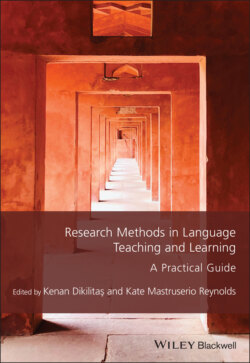Читать книгу Research Methods in Language Teaching and Learning - Группа авторов - Страница 31
Developing the Study: Why Ethnographic Diaries?
ОглавлениеEthnographic research can draw upon a wide range of data collection tools, including observations and field notes; questionnaires, interviews and focus groups; and participant self-report mechanisms such as diaries (Avineri, 2017). In my study, participants recorded their experiences and perceptions of a series of lessons in diaries, this approach being complemented by other data collection methods for subsequent triangulation – lessons were also observed and recorded, while the diary entries provided the basis for follow-up interviews that further explored participants’ reported experiences and insights, that is, the “diary-interview method” (Zimmerman & Wieder, 1977).
I decided to make diaries, rather than the other data collection tools, the central element of the study (and, therefore, this chapter’s discussion) as they offered participants the opportunity to provide “a first-person account of a language learning or teaching experience, documented through regular, candid entries,” which reported and reflected on those aspects that they themselves found significant (Bailey, 1991, p. 215). Giving more control to the research participants themselves than, for example, interviews, observations, or questionnaires, diaries are “self-report instruments used repeatedly to examine ongoing experiences” (Bolger et al., 2003, p. 580), which diarists keep as openly and honestly as possible (Bailey, 1983). Their key characteristics are thus: their regularity (regular timed and/or dated entries are made over a period of time); they are personal, kept by identifiable individuals, who also control access to the diary; entries are contemporaneous, made at or close to the time of experiences and events, rather than recalled and documented a significant time later; and they are a record of what the diarist considers relevant and important at that time, and might include activities, thoughts and feelings, interactions and so forth (Alaszewski, 2006); although participation in a diary-based research study might require diarists to focus on a particular aspect of their life or learning experience (ibid.).
Diaries therefore seemed well suited to my ethnographic investigation of a particular language classroom. They offered participants the opportunity to record introspective reflections on their own experiences (Bailey, 1983), through which I could start to uncover the social and psychological processes operating within the classroom – a “unique situated reality” embedded within layers of context (Blommaert & Jie, 2010, p. 17). I hoped that the diaries could capture the hard-to-reach thoughts and “little experiences” of everyday life in the classroom that occupy much of teachers’ and learners’ conscious attention (Wheeler & Reis, 1991, p. 340, cited in Bolger et al., 2003), enabling me to discover and examine reported experiences in their natural and (almost) spontaneous context; by reducing the amount of time between an experience and the recording of that experience, using diaries was likely to significantly reduce the extent of recall error or bias compared to approaches such as interviews (Alaszewski, 2006; Bolger et al., 2003). And they could reveal the complexity of classroom life by prioritizing the participants’ experiences and beliefs, drawing upon their “emic” (Richards et al., 2012) perspectives on events and contexts (i.e., participants’ own “insider” understandings). Central to my use of diaries was the aim of providing participants with more “voice” within the study, compared to other research tools and data sources, while I would move from a position of “ignorance” at the start of a study to become a “knower” through a process of diary data collection and analysis (Blommaert & Jie, 2010). The diary study was thus intended to provide me with a means of unpacking what is often taken for granted in the classroom, those “common sense” assumptions about teaching and learning that I wanted to move beyond (see Introduction).
However, beyond this broad understanding of how the use of ethnographic diaries would develop my understanding of the classroom, there remained a range of questions concerning the practicalities of diary design and implementation, while the subsequent analysis of data also raised a number of dilemmas; as Janssens et al. (2018, p. 1) acknowledge, there is “no golden standard for the optimal design of a diary study.” Moreover, within applied linguistics research and, more specifically, within research into language teaching and learning, diaries are often undervalued or overlooked as a possible means of collecting data (Rose et al., 2020);1 there were thus few methodological models for me to follow within the research literature. Like all diary-oriented researchers, therefore, I faced a series of choices when designing my approach. Decisions would need to reflect both the aims of my project and also take into account any practical constraints on the research (e.g., the need to find both willing and appropriate – i.e., potentially informative – participants; maintaining their participation over the course of the study; acknowledging and accommodating any time constraints they may be under). However, my choices would also affect the quality, integrity, and interpretability of the project’s data.
It is to the process of finding participants that the discussion now turns, subsequently moving on to examine the methodological choices underpinning the design of the diaries themselves, as these decisions were in part shaped by the participants’ perspectives and related practicalities.
